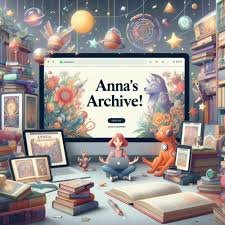Exploring Anna Archive: The Open Library Revolutionizing Digital Access

Anna archive In an age where access to knowledge is increasingly becoming digitized and democratized, the name Anna Archive is gaining serious traction among readers, researchers, and curious minds across the globe. But what exactly is Anna Archive? Why is it making waves in the digital library community? And what are the legal and ethical conversations surrounding it?
In this article, we’ll take a deep dive into the world of Anna Archive — from what it offers and how it operates, to the controversies it courts and the cultural value it provides.
What is Anna Archive? An Introduction to the Platform
Anna Archive is essentially an online repository — a vast digital library filled with books, articles, and academic texts. At first glance, it feels like a haven for bibliophiles and researchers. The platform offers a staggering number of downloadable books, often in PDF, EPUB, or other reader-friendly formats. And the best part? It’s free.
What sets Anna Archive apart is its sheer size and simplicity. There’s no need for a fancy account, no credit card required, and no paywall standing between you and the knowledge you seek. In fact, many users compare it to other well-known open-access platforms, such as Library Genesis (LibGen) and Sci-Hub, although Anna Archive operates with its own unique structure and collection.
Another defining characteristic of Anna Archive is its user-friendly design. No fluff, no flashy graphics—just a clean, straightforward interface that lets you search and download books easily. Whether you’re looking for technical manuals, academic journals, or classic literature, chances are you’ll find it here.
The Philosophy Behind Anna Archive: Free Access to Knowledge

At its core, Anna Archive is built on a powerful and somewhat rebellious idea: knowledge should be free. This concept isn’t new, but platforms like Anna Archive bring it into sharp focus by challenging traditional publishing norms and academic gatekeeping.
The archive champions educational equality. In many parts of the world, access to books—especially academic or scientific texts—is incredibly limited due to cost and distribution barriers. Anna Archive breaks those walls down, offering students in developing countries the same access to educational resources as those in wealthier regions.
The platform also indirectly highlights a broken system in the world of publishing. Many users feel that paying hundreds of dollars for a textbook—or even for access to a single article—is unfair, especially when the research is publicly funded. By offering a free alternative, Anna Archive not only solves a problem but also forces people to question the system that created the problem in the first place.
However, this philosophy isn’t without critics. Some argue that free access to copyrighted material undermines authors and publishers. Yet others believe that in an ideal world, knowledge wouldn’t have a price tag attached to it at all.
How Anna Archive Works: A Look Under the Hood
Anna Archive isn’t a random stash of files thrown onto the web. It’s actually quite organized. Think of it like a digital warehouse with an incredibly efficient indexing system. You can search by title, author, ISBN, or even subject matter. Once you find the book you’re looking for, downloading it is usually just a click away.
The platform sources its content through a combination of community contributions and file-sharing technologies. Much of its material is mirrored from other well-known sources like LibGen or Z-Library (when it was still widely available). Some files are uploaded by users who believe in the archive’s mission to make knowledge accessible to everyone.
It’s important to note that the actual hosting is often decentralized. That means the archive doesn’t always hold the files directly. Instead, it connects you to third-party mirrors or decentralized databases, much like how torrents work. This makes the platform more resilient to shutdown attempts and takedown notices.
Another technical marvel is the search algorithm. Despite being simple, it’s incredibly effective. Search results are fast and surprisingly accurate, which is something you don’t always get with large-scale, open-access archives.
Is It Legal? The Controversial Side of Anna Archive
Let’s talk about the elephant in the room: the legality of Anna Archive. Is it even legal to use? Short answer: it’s complicated.
Many of the books available on Anna Archive are still under copyright. That means downloading or distributing them without permission violates intellectual property laws in most countries. This puts the platform—and its users—in a grey area legally. Some governments have already taken steps to block or restrict access to similar platforms.
That said, enforcement is inconsistent. Some regions turn a blind eye, especially when the platform is being used for academic or personal research purposes. Others take a more aggressive stance, issuing takedown notices and attempting to shut down domains.
Despite these legal clouds, many users feel morally justified in using Anna Archive. They argue that the current academic publishing model is exploitative, charging high fees for access to knowledge that should belong to the public. In their view, Anna Archive is more of a digital protest than a pirate hub.
Still, if you’re considering using the platform, it’s wise to understand your local laws and tread carefully. Some people choose to use VPNs or other privacy tools to reduce risk.
Cultural Impact: Why Anna Archive Matters
Despite all the controversy, the cultural impact of Anna Archive is undeniable. For many, it’s not just a library — it’s a lifeline. Students who can’t afford expensive textbooks now have a chance to complete their education. Researchers in remote areas can finally access the studies and materials they need. Even casual readers benefit by discovering books they otherwise couldn’t afford or find.
The platform also fosters a sense of digital community. Users often recommend books, share links, and even help each other navigate complex academic subjects. This kind of grassroots collaboration is rare and valuable in today’s fast-paced, commercialized internet landscape.
Anna Archive has also become a symbol of resistance against gatekeeping. It represents a broader movement where digital spaces are reclaimed for public good, rather than corporate profit. In this way, it’s not just about books—it’s about reclaiming access, autonomy, and opportunity.
The Future of Anna Archive: What’s Next?
As Anna Archive grows, so does the scrutiny. It’s likely that more legal challenges will arise, and certain domains may be taken down. But like other decentralized or mirrored projects, the archive is built to be resilient. Even if one version is removed, others can and often do pop up elsewhere.
One possible future for Anna Archive lies in legal reform. If the pressure it creates helps push for fairer pricing in academic publishing, then the platform will have succeeded in its mission—even if it doesn’t survive in its current form.
Another path could be greater decentralization. With blockchain-based storage solutions and decentralized file sharing, archives like Anna Archive could become even more resistant to censorship and legal pressure. That would turn it from a controversial website into a permanent, unstoppable resource.
Regardless of where the platform goes next, one thing is clear: the demand for open access to information isn’t going away. Anna Archive is part of a much bigger shift—one where knowledge is no longer locked behind a paywall, but shared freely across the world.
Conclusion: Anna Archive and the Battle for Knowledge Freedom
At the end of the day, Anna Archive is more than just a digital library. It’s a bold statement about who gets to access knowledge and under what terms. Whether you see it as a hero or a legal minefield, there’s no denying its significance.
In a world where information is power, Anna Archive is helping to level the playing field. It’s not perfect, and it certainly walks a fine legal line, but it’s also a glimpse into what the future of education and digital access could look like—free, open, and accessible to all.



